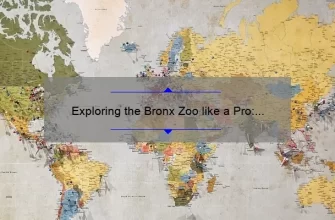Short answer how many elephants are at the Bronx Zoo: As of September 2021, there are three Asian elephants residing in the Bronx Zoo – Maxine, Pachy and her daughter Bharti. The zoo is accredited by the Association of Zoos and Aquariums (AZA) for their elephant management program.
- Frequently Asked Questions About How Many Elephants Are at the Bronx Zoo
- Top 5 Fascinating Facts about the Elephants at Bronx Zoo
- 1. Their Trunks Are Multifunctional
- 2. They Have an Incredible Sense of Smell
- 3. Elephants Can Live Up To 70 Years!
- Going Beyond Numbers: The Lives and Conservation Efforts of Bronx Zoo’s Elephant Herd
Frequently Asked Questions About How Many Elephants Are at the Bronx Zoo
The Bronx Zoo is one of the largest metropolitan zoos in the United States. With over 265 acres, it’s home to thousands of animals representing hundreds of species from all around the world. As you wander through its sprawling grounds, you may find yourself wondering: “How many elephants are at the Bronx Zoo?” It’s a question that we hear quite often, and rightly so! Elephants are remarkable creatures – gentle giants with incredible memory and social skills.
So without further ado, let me answer some frequently asked questions about how many elephants currently live at the Bronx Zoo:
1) How Many Elephants Live at The Bronx Zoo?
Currently, there are seven African elephants living happily at the Bronx Zoo. All seven elephants are female; they range in age from four years old (youngsters named Pili and Kaia), up to our resident matriarch Anne who recently celebrated her sixtieth birthday!
2) Why Only Female Elephants?
African elephant society operates around family units composed of females led by a matriarch or an older female with extensive knowledge about resources available within their environment. Therefore maintaining multiple male orangutans with different personalities creates complexities for managing these groups compared to all-female-groups.
3) Who is Anne, and why does she matter?
Anne arrived at The Bronx Zoo when she was just three years old back in 1962. She quickly became something special – not just due to her size (she weighs almost nine tons!) but also because she demonstrated an incredibly stable personality ideal as a leader for other female members of their group based on longevity it gives weightage honorific title “Matriarch”. After more than five decades as part of our zoo family – including several births under her watch – each day brings new joy shared between her keepers and visitors alike.
4) What Happens if There Is An Elephant Birth At The Settling Place
If lucky enough to experience an elephant delivery, visitors can expect a tremendous amount of joy and anticipation within the zoo community. Settling is where our animal welfare professionals keep a close eye on pregnant mothers ready to give birth. They have established supportive systems for natural deliveries using positive reinforcement training or more urgent assistance methods if required.
5) What Makes Elephants So Special?
Elephants are not just cute and cuddly creatures; they also play an essential role in keeping the ecosystem healthy. Their interactions with other animals as well as their remarkable memory helps maintain biodiversity by promoting vegetation growth and even dispersing seeds throughout their habitat range.
In conclusion, “How many elephants live at The Bronx Zoo” might be one of those frequently asked questions, but it’s easy to see why! Our seven residents (including the incomparable Anne!) represent some of nature’s most incredible wonders – gentle giants whose contribution to their wild counterparts’ survival knows no bounds. With multiple exhibits designed around conservation education efforts showcasing these magnificent beasts, we welcome you for your next visit!
Top 5 Fascinating Facts about the Elephants at Bronx Zoo
Elephants are one of the most beloved animals in the world, and for good reason. They’re intelligent, social creatures with a trunk full of personality! The Bronx Zoo is home to several magnificent elephants that never cease to amaze visitors.
In this blog post, we’ll take a closer look at some of the fascinating facts about these majestic creatures at the Bronx Zoo.
1. Their Trunks Are Multifunctional
An elephant’s trunk is incredibly versatile – it can pick up everything from peanuts to tree trunks! But did you know their trunks also have over 100,000 muscles? This allows them to manipulate objects with incredible precision and strength. Elephants use their trunks to lift heavy logs or branches out of their way as they travel through forests or scrublands.
2. They Have an Incredible Sense of Smell
Elephants possess an extraordinary sense of smell – much better than ours! A wild elephant can distinguish between hundreds of different scents thanks to its millions of olfactory receptors in its nose! Even more impressive, they’re able detect water sources from miles away during droughts when all else seems lost.
3. Elephants Can Live Up To 70 Years!
Did you know that elephants can live up to 70 years old? That’s almost longer than most humans on average!! These gentle giants mature slowly but make loyal companions throughout life while living rich emotional lives filled with romance, heartbreak, parenting struggles & ultimately bonding bonds for families even after death itself bids farewell sadly…For keepers who care for them at The Bronx Zoo throughout life span alongside various others working behind-the-scenes know just how special each one truly is as there exist only few (approx..14) managed-care institutions in North America sheltering African forest habitat-oriented species like theirs’…
4. Baby Elephants Weigh Less Than Your Briefcase
When born baby elephants typically weigh around 200 pounds which is lighter than your typical briefcase however within the first year of their life they can grow to weigh as much as 1,500 pounds! Under the right care and circumstances where stress minimizes mothers are known to have a strong bond with their young protecting them from harm while showcasing nurturing behavior.
5. Elephants Show Empathy for Others
Studies show that elephants exhibit empathy toward one another, which means they’re able to understand and share each other’s emotions. For example, when an elephant sees another in distress or mourning after losing a family member or friend, it will often stop what it’s doing and stay nearby until assured that the other is OK before moving forward again…
In conclusion, these top five fascinating facts only just scratch the surface of how amazing elephants truly are at Bronx Zoo!!! They show us incredible depth in understanding social bonds between mother & child relationships while displaying traits endemic towards wild African community-like habitat-oriented groups themselves!! So next time you visit The Bronx zoo , make sure you take some extra minutes out of your day so that you can marvel in awe at these magnificent creatures!
Going Beyond Numbers: The Lives and Conservation Efforts of Bronx Zoo’s Elephant Herd
The Bronx Zoo’s elephant herd is one of the largest in North America with a total of seven elephants, three females and four males. However, their significance goes beyond just being a large group of animals residing in an urban environment. These magnificent creatures have their own stories to tell- stories filled with trials and tribulations that ultimately led them to become ambassadors for their species.
Let’s delve into the lives of these majestic creatures, starting with Happy – The Matriarch:
Happy arrived at the Bronx Zoo in 1977 as a wild-caught calf from Thailand. She was only six months old when she was separated from her mother and forcibly removed from her native habitat. Tragically, this is still happening today; elephants are being captured, sold and sent all over the world for human entertainment purposes such as trekking or performing in circuses.
Happy has since lived most of her life in captivity but been instrumental in helping researchers understand more about elephant intelligence levels through cognitive testing programs based on positive reinforcement rewards systems like food!
“Testing cognitive abilities enables us to better appreciate how intelligent these incredible beings truly are,” says Assistant Curator Draper Shreeves.
Next up: Saba – The Survivor
Saba came to the US after surviving poachers who killed both her mother and sister right before her eyes while she was attempting to fend off attackers at only two years old. Luckily she was found alive by conservationists who brought Saba into protective care until eventually reaching Bronx zoo sanctuary where she now thrives among her fellow herd members protected by dedicated professionals committed to rescuing elephants threatened by poaching, illegal trade including confiscations under wildlife trafficking laws.
Nabisco’s Untimely Death
Sadly Nabisco passed away earlier this year due sudden acute colic caused by intestinal inflammation which had lasted several days (colic occurs frequently among captive-raised horses). He would have turned 43 next month on August 1st. While his passing is a tragic loss, it has also served as an opportunity to raise awareness about elephant care and welfare worldwide especially in captivity.
Efforts by animal welfare groups like Elephant Voices are more critical than ever given the increasing amount of human encroachment on elephant habitats, making natural ecosystems difficult to maintain while poaching increases dramatically (ivory prices remain high). The Bronx Zoo provides an excellent example for how well managed conservation efforts can lead to happy long healthy lives for these highly intelligent creatures that bring wonder and awe into our world.
In conclusion
The elephants at the Bronx Zoo remind us of what we stand to lose should we continue exploiting such marvelous beings without thought beyond the momentary entertainment they provide.
It’s up to each one of us individually – companies, organizations, people who love animals -to generate positive change needed before wild elephants become extinct due mostly from habitat destruction leading to inevitable starvation or poaching caused by illegal ivory trade because once all gone its far too late…for everyone!








